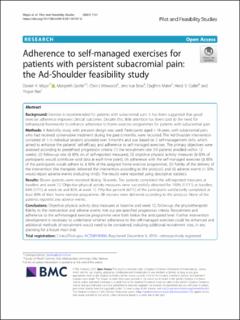| dc.description.abstract | Background Exercise is recommended for patients with subacromial pain. It has been suggested that good exercise adherence improves clinical outcomes. Despite this, little attention has been paid to the need for behavioural frameworks to enhance adherence to home exercise programmes for patients with subacromial pain. Methods A feasibility study with pre-post design was used. Participants aged > 18 years, with subacromial pain, who had received conservative treatment during the past 6 months, were recruited. The Ad-Shoulder intervention consisted of 1–5 individual sessions provided over 3 months and was based on 5 self-management skills, which aimed to enhance the patients’ self-efficacy and adherence to self-managed exercises. The primary objectives were assessed according to predefined progression criteria: (1) the recruitment rate (10 patients enrolled within 12 weeks), (2) follow-up rate (≥ 80% on all self-reported measures), (3) objective physical activity measures (≥ 80% of participants would contribute valid data at each time point), (4) adherence with the self-managed exercises (≥ 80% of the participants would adhere to ≥ 80% of the assigned home exercise programme), (5) fidelity of the delivery of the intervention (the therapists delivered the intervention according to the protocol) and (6) adverse events (< 30% would report adverse events (including mild)). The results were reported using descriptive statistics. Results Eleven patients were recruited during 16 weeks. Ten patients completed the self-reported measures at baseline and week 12. Objective physical activity measures were successfully obtained for 100% (11/11) at baseline, 64% (7/11) at week six and 82% at week 12. Fifty-five percent (6/11) of the participants satisfactorily completed at least 80% of their home exercise programme. All sessions were delivered according to the protocol. None of the patients reported any adverse events. Conclusions Objective physical activity data measures at baseline and week 12, follow-up, the physiotherapists’ fidelity to the intervention and adverse events met our pre-specified progression criteria. Recruitment and adherence to the self-managed exercise programme were both below the anticipated level. Further intervention development is necessary to understand whether adherence to the self-managed exercises could be enhanced and additional methods of recruitment would need to be considered, including additional recruitment sites, in any planning for a future main trial. | |
